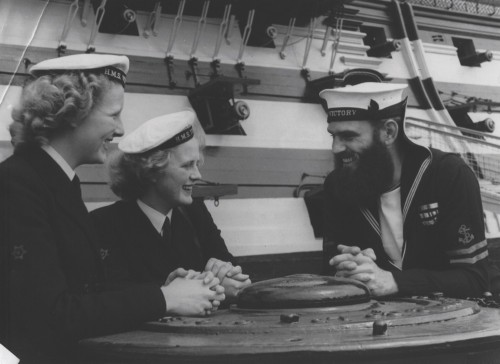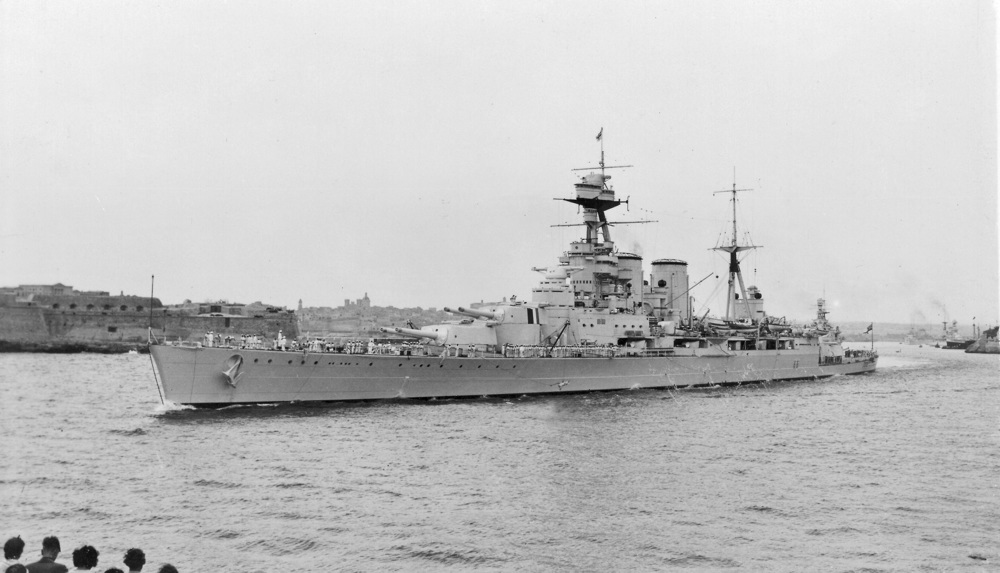Don’t give
up the ship
Yorkshireman Bob Tilburn was one of only three survivors when HMS Hood was sunk in the Second World War. A relative recalls his story
Seventy-five years ago a calamitous event lowered the nation’s spirits in what were already some of the darkest days of the Second World War. Battle-cruiser HMS Hood – the pride of the British Navy and nicknamed the Mighty Hood – had gone into battle against the German battleship Bismarck in the North Atlantic and been sunk. All but three of the crew of 1,418 men were dead.
Among the survivors was Bob Tilburn. Born in Leeds in 1921, he seemed destined to serve at sea following a family holiday at the age of 10 to Portsmouth, where the big ships of the interwar years made a huge impression on him.
In May 1941 the then able seaman Tilburn – my great-aunt’s step-son – was 20 and part of the crew of the Hood as it steamed flat out to intercept the Bismarck and the heavy cruiser Prinz Eugen in the Denmark Strait between Greenland and Iceland. Tilburn – dubbed Lofty by his mates due to his towering stature – was part of a team manning one of the 4-inch anti-aircraft guns.
They were not the main armament of the ship – the Hood had four primary gun turrets, each housing a twin-barrelled 15-inch gun. Each shell weighed almost a tonne and could hit a target 17 miles away.
It was formidable firepower but it would be needed. It was the Hood’s job to stop the Bismarck breaking out into the wider Atlantic where it would surely wreak havoc with British merchant shipping. The Hood’s crew had the confidence that came with their ship’s reputation of power and invincibility. Yet the truth was that it was no match for its German counterpart. The Hood was built 20 years before the Bismarck and had sacrificed armour plating on the decks in order to increase speed. The Bismarck had modern, more effective gunnery control systems.
“No one thought the Hood would be sunk – no one gave it a thought.”
Not until some years after the battle was Tilburn cleared to tell his story of that fateful encounter early in the morning of 24 May 1941.
“Everyone was prepared as far as they could be,” he said in a 1950s account. “Everyone knew there would be casualties – but it would be someone else, not you. No one thought the Hood would be sunk – no one gave it a thought.”
The anti-aircraft guns were not needed in the engagement and their crews, including Tilburn, were ordered to take cover in the recreation space at the base of the bridge. All obeyed except a handful, Tilburn among them. They lay by their gun, joking to relieve the tension.
Shortly before 6am both sides opened fire. Tilburn remembered seeing flashes as the Bismarck fired its guns. The German shells began to find their mark.
“A shell came over with a frightening noise, like an express train rushing at us. There was a deafening explosion. We leapt up to find the forward anti-aircraft gun had been hit and ammunition was exploding. The next salvo hit the space where the anti-aircraft crews had gone for shelter. Another salvo hit the top of the mast where officers were directing our fire. The upper structure was blown away. Debris and bodies fell all over the deck. Next moment came a terrific explosion aft. Complete silence followed. My companions were dead.”
One of the Bismarck’s shells is thought to have penetrated the deck and detonated in an armament magazine. The damage was catastrophic.
Tilburn staggered to the side. Looking back, he saw the Hood’s bows rearing up. It was clear the ship was going down quickly. Tilburn found himself in the water, where a section of mast struck him on the leg and a wire aerial snagged one of his boots, pulling him under. He managed to cut off the tangled boot with his knife and shot back up to the surface.

A strong swimmer, he made his way to the other survivors – midshipman William Dundas and signalman Ted Briggs. As time went on, Tilburn and Briggs started to succumb to the cold but Dundas kept them going by singing Roll Out The Barrel and other songs and getting them to join in.
Tilburn recalled the moment when they spotted the British destroyer Electra heading to their rescue. “It was a marvellous sight,” he said. They had been in the freezing sea for three hours and were close to death. The Electra took them to Reykjavik, where they were transferred to hospital. Soon Tilburn was back home with his family in Leeds. With the others, he was treated as a national hero. Newspapers showed pictures of him leaving the family’s modest semi to go for a walk with his younger brother Brian.
The loss of HMS Hood and so many lives was met with widespread shock in Britain. Prime minister Winston Churchill signalled to the fleet: “The Bismarck must be sunk at all costs.” Crippled by Swordfish aircraft from Fleet Air Arm, the Bismarck was engaged by the battleships HMS King George V and HMS Rodney on the morning of 27 May 1941 before being sunk with torpedoes, again with huge loss of life.
Later in the war Tilburn served on the battleship Queen Elizabeth, which saw action in the Far East, and he was still in the Navy during the Korean War in the early 1950s, when he was on the aircraft carrier HMS Warrior.
“Bob was quiet and unassuming,” his step-daughter, Barbara Petrie, tells me. “He was easily pleased and lived a simple life, hating fuss. He was just a very ordinary, humble person. He never felt he had been ‘saved’ for any particular purpose – he just felt he had been fortunate. He used to say he knew he was never going to win the football pools because he had had all his luck early on in life.”
After leaving the Navy, Tilburn lived in Stockton-on-Tees, working at the Inland Revenue and at a petrol station in the evenings to make ends meet. He died in 1995, aged 74.
Now the story of the Hood, its three survivors and all those who died is set for new recognition. This May, to mark the 75th anniversary of the sinking, a new exhibit will go on display at the National Museum of the Royal Navy in Portsmouth. It is the ship’s bell, retrieved from the floor of the Atlantic last year by a team led by American philanthropist Paul Allen.
Nick Hewitt, head of heritage development at the museum, says the bell is undergoing conservation work with the Mary Rose Trust. “This is something that has been at the bottom of the sea for 74 years. It has an imprint of a chain that had been hanging across it in the wreck. Clearly it’s an artefact that went to war and was sunk.”
The recovery of the Hood’s bell has been supported by the HMS Hood Association, set up to immortalise the story of the ship and its crew. Rear admiral Philip Wilcocks is the president of the association; his uncle, able seaman Eric Wilcocks, was lost when the ship went down.
“When the offer of help came from Paul Allen we felt it was appropriate to have an entity to remember the people killed,” says Wilcocks. “The loss of 1,415 men was the largest single loss of life in the history of the Royal Navy. It was the equivalent of three battalions of troops gone in less than five minutes.”
Hewitt says: “Even people who have no interest in naval history have still heard of the Hood and the Bismarck. People are very connected with that story and it has become lodged in the public imagination.”
Petrie says Tilburn’s family are pleased the ship’s bell has been recovered. “I believe it will ensure we have a permanent, tangible memorial to all those who served on the magnificent Hood and to what happened,” she says. “We need to remember.”

Leave a reply
Your email address will not be published.